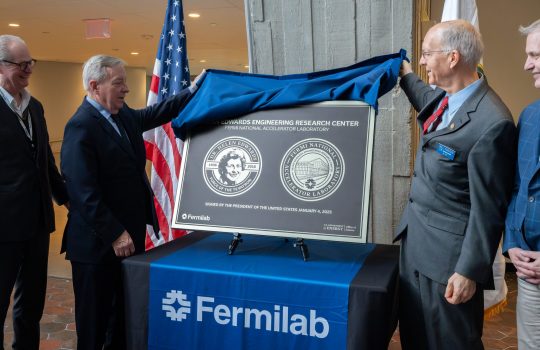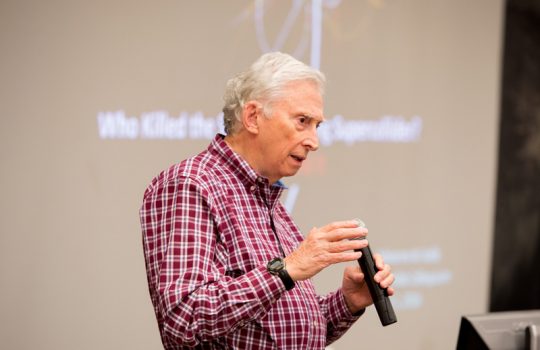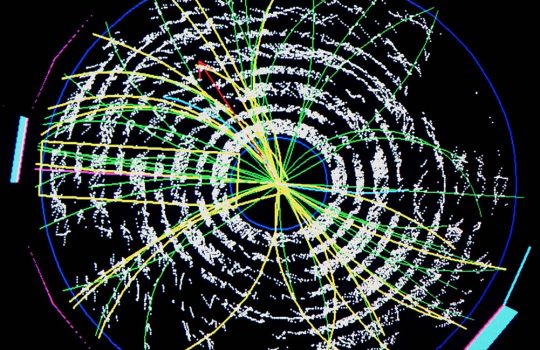Batavia, Ill-Officials at the Department of Energy’s Fermi National Accelerator Laboratory today (March 1) announced the start of Collider Run II at the Tevatron, the highest-energy particle accelerator now operating in the world. Researchers at Fermilab hope that high-energy particle collisions at the Tevatron in Run II will yield significant, long-awaited discoveries about the fundamental nature of matter in the universe.
Fermilab Director Michael Witherell expressed satisfaction at the culmination of the laboratory’s decade-long preparations for Run II and anticipation of the scientific opportunities it will provide.
“I am delighted that we are starting Run II on time,” Witherell said. “Now we can look forward to the excitement of seeing new physics results. We can’t predict what Nature has in store for us. All we can guarantee is the opportunity for discovery.”
Like Witherell, many Fermilab scientists stressed that, while they have models and theories, they do not know what new physics Run II will reveal. Nevertheless, world attention has focused on Fermilab’s two collider detectors at the Tevatron, CDF and DZero, as the next possible venue for discovery of the Higgs boson, an as-yet-unseen particle that physicists believe may determine the property of mass. Late last year, experiments at the Large Electron Positron collider at CERN, the European Laboratory for Particle Physics, detected hints of what might have been signals of the Higgs. However, the LEP accelerator shut down before scientists there could either confirm or rule out a Higgs sighting. If the Higgs boson does exist at a low enough mass, Fermilab experiments may be able to detect it during Run II.
Run II also has the potential for revealing much more new physics, including evidence for a theoretical model known as supersymmetry, signals of possible extra dimensions in the universe, new insight into the asymmetry between matter and antimatter and a better understanding of the top quark, discovered at Fermilab in 1995 during Collider Run I. All are subjects with profound implications for modern particle physics and for the understanding of the fundamental physical workings of the universe.
“Two recent results from other experiments add to the excitement of Run II,” said Fermilab theorist Joseph Lykken. “The results from Brookhaven’s g-minus-two experiments with muons have a straightforward interpretation as signs of supersymmetry. The increasingly interesting results from BABAR at the Stanford Linear Accelerator Center add to the importance of B physics in Run II, and also suggest new physics. I will be shocked and disappointed if we don’t have at least one major discovery.”
During Run II, beams of protons at an energy of 980 billion electron volts will collide with beams of antiprotons at the same energy, for a total energy of 1.96 trillion electron volts at the collision point, a 10 percent increase over the energy of Run I. However, the greatest enhancement of the Tevatron’s capability will come from the use of a new injection accelerator, the $260 million Main Injector, completed in 1999. The Main Injector and other improvements will permit a much greater rate of high-energy collisions in the Tevatron, providing more than a 20-fold increase in the number of particle collisions observed and recorded at the particle detectors. Because the new phenomena that physicists are seeking occur extremely rarely in particle collisions, the increased collision rate is critical to making discoveries.
Although Collider Run II officially began on March 1, it will take some weeks before Fermilab physicists begin seeing physics results from the upgraded and newly configured Tevatron.
“Turning on the Tevatron is not like turning on a toaster,” said Fermilab Operations Chief Robert Mau, whose department operates Fermilab’s accelerators. “Besides the approximately seven miles of particle beam enclosures, the accelerator complex includes 44,000 controllable devices and more than a hundred thousand readbacks. Millions of components, circuits and parts all have to work together. The Tevatron is one of the most complex devices on earth. It takes a while to get it up and running.”
Mau expects to see proton beams in the Tevatron within a few days. Experiment collaborations at the CDF and DZero detectors should begin observing proton-antiproton collisions later in March. The collaborations, each comprising about 550 physicists from universities and laboratories throughout the nation and the world, have each completed five-year, $100-million upgrades to take advantage of the Tevatron’s enhanced capabilities.
“Our sensitivity to new physics comes not only from the big increase in numbers of collisions,” said CDF collaborator Rob Roser. “We gain an additional factor due to beam energy and a further increase due to the improvements in our detector. For top-quark physics, for example, we are looking at about a 50-fold improvement over Run I.”
Run II will continue, with a mid-course interruption for further upgrades and improvements to accelerators and detectors, until 2007. At about that time, results will begin to emerge from a new accelerator, the Large Hadron Collider at CERN, which will have seven times the Tevatron’s energy and will overtake the Tevatron at the high-energy frontier. Fermilab scientists are eager to make the most of the opportunities now before them.
Experimenter Robin Erbacher expressed the prevailing sentiment among physicists at the laboratory after five years of work and preparation for Run II.
“I’m ready to get my hands on some data and analyze it,” Erbacher said.
Fermilab is operated by Universities Research Association, Inc., under contract with the U.S. Department of Energy, whose Office of Science funds more than 90 percent of the federally supported research in high-energy physics in the United States.



